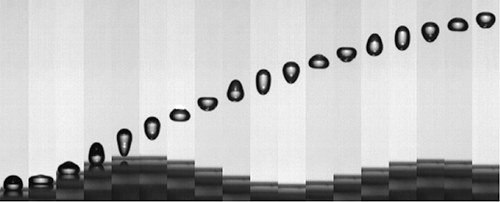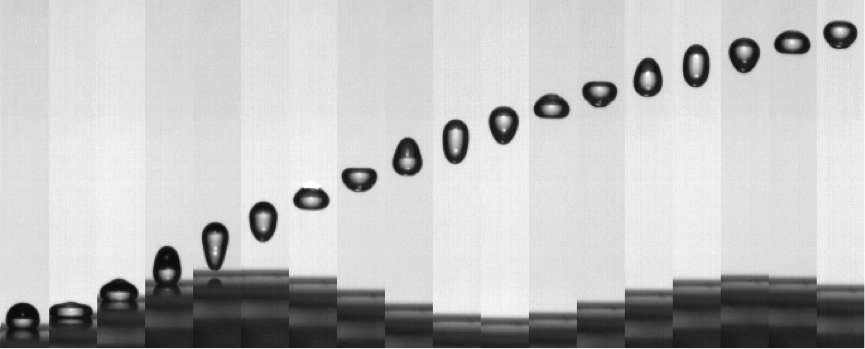Superpropulsion of Liquid Drops
A solid surface, oscillating up and down, can launch a soft, wobbly ball into the air at higher speed than it would launch a hard ball of the same mass. That’s the surprising conclusion of a study by researchers in France, who demonstrate that a kind of synchronization between the internal vibration of a projectile and the frequency of the rising and falling surface can more than double the projectile’s kinetic energy. The phenomenon could have applications in ballistics or in microfluidic technology.
The new finding comes out of an investigation by Christophe Raufaste of the University of Côte d’Azur in Nice, France, and his colleagues into the motion of liquid drops on highly water-repellent (superhydrophobic) surfaces. Previous experiments have shown that, because water droplets have essentially no propensity to stick and spread on such surfaces, they can bounce like rubber balls [1].
The team wondered what would happen if a droplet initially resting on a superhydrophobic surface were propelled upward by the surface rapidly rising and then descending again. They imagined that the droplet might cleanly detach from the surface and keep rising, as if shot up by a catapult.
Raufaste and colleagues confirmed that this was so by launching water droplets of around 0.5–1.8 mm in diameter from a surface made of fluorinated polymers (similar to Teflon). A finely textured microstructure rendered the surface superhydrophobic, and the team caused it to rise and fall with a smooth, wavelike motion at various frequencies between 20 and 70 Hz. The droplets flew upward as the surface fell back from its highest point.
The greatest upward speed of the surface occurred halfway to its peak height. Unexpectedly, the researchers found that some droplets left the surface at about 1.6 times that speed. To understand how a droplet could ascend faster than the surface that propelled it, the researchers took a close look at the interaction between the squishy droplet and the moving surface.
A liquid droplet becomes flattened initially as the surface rises beneath it, just as a tennis ball deforms when hit by a racket. But then the droplet springs back, becoming elongated in the vertical direction. It continues to vibrate in this way as it rises.
This oscillating deformation, the researchers found, can increase the upward motion of the droplet’s center of mass, a phenomenon they dubbed “superpropulsion.” The biggest boost came when the droplet’s vibration frequency (which depends on its size) was about 3 times the oscillation frequency of the surface. In that case, its kinetic energy at launch was a full 2.5 times greater than that of a rigid ball, whose maximum speed could not exceed the upward speed of the surface. “We called it ‘one-shot resonance,’ since everything happens during the first period” of the surface vibration, says Raufaste.
The phenomenon is like a trampolinist timing her jumps to maximize her upward thrust. “The trampolinist pushes at the right moment to increase her kinetic energy at each period,” says Raufaste.
The researchers reasoned that this effect should also work with solid, elastic balls. They made balls of a soft, water-absorbing polymer (polyacrylamide), whose size and softness depended on how long they were soaked in water. The team found again that the maximal boost occurred when the ball’s internal vibration frequency was about three times that of the launching surface.
Raufaste says that the effect could be useful for saving energy in technologies that involve propulsion of soft or fluid objects. “For slingshots, archery, and catapults,” he says, “only part of the initial elastic energy is transferred to the projectile. We could significantly increase the energy transfer by accounting for the deformation dynamics of the projectile or the acceleration dynamics of the projecting engine.” He says that the same principles could also apply to elastic systems that launch aircraft from ships.
This is “a carefully controlled experiment combined with a simple but powerful physical model able to capture the main effects observed,” says fluid mechanics specialist Alfonso Castrejon-Pita of the University of Oxford in the UK. He suggests that the effect might also be used for size-dependent sorting or removal of droplets, for example in microfluidic lab-on-chip devices.
This research is published in Physical Review Letters.
–Philip Ball
Philip Ball is a freelance science writer in London. His latest book is How Life Works (Picador, 2024).
References
- D. Richard, C. Clanet, and D. Quéré, “Surface Phenomena: Contact Time of a Bouncing Drop,” Nature 417, 811 (2002).





